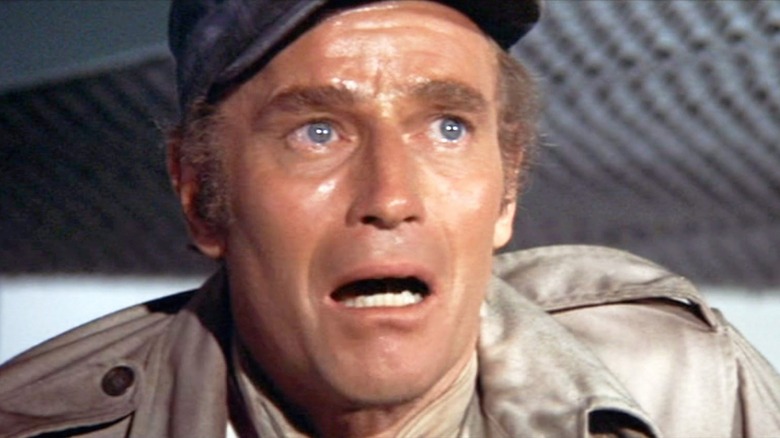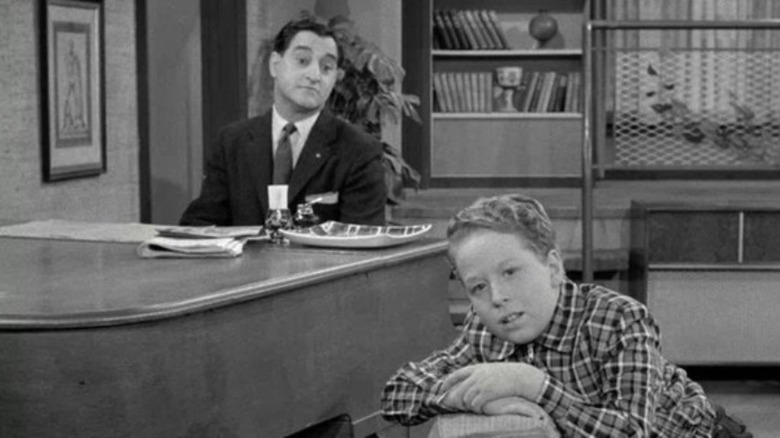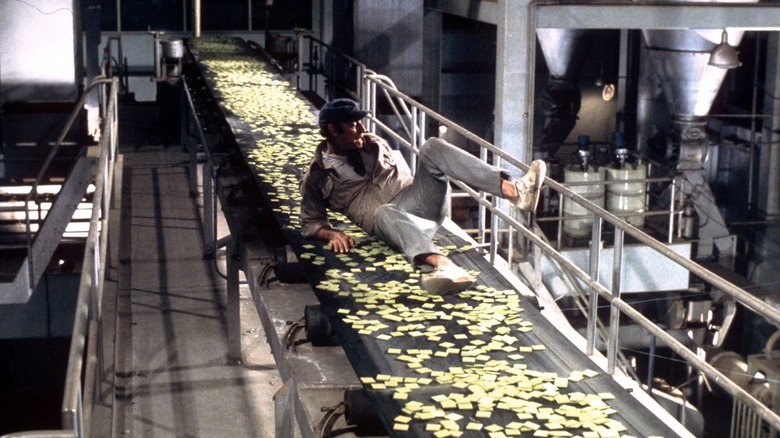A Long-Dead TV Show Forced Soylent Green To Change Its Name
Richard Fleischer's 1973 dystopian sci-fi film "Soylent Green" takes place in the distant future of 2022 when Earth's resources are dwindling, thanks to overpopulation and climate change. Food sources are becoming scant and difficult to maintain. Food and water are rationed for everyone (except for the wealthy, of course), and the most common foods are small processed crackers called Soylent Red and Soylent Yellow (named for their two ingredients: soy and lentils). A new flavor is taking the populace by storm: Soylent Green is said to be made from plankton and possessed of a much better flavor. It seems that a recent thriving biome was discovered on the ocean floors.
This is a bleak future, and citizens are encouraged to volunteer for euthanasia to keep the population down. The government provides special death rooms where people can relax to calming music and lovely forest scenes as they receive lethal injections.
Charlton Heston plays an NYPD cop named Robert Thorn who is tasked with finding the murderer of a local billionaire who held a sinister secret about Soylent production. He finds some information about the plankton used to make Soylent Green, notably, that there isn't any. So what is Soylent Green made from? Any sci-fi worth their salt knows very well what the secret ingredient is.
"Soylent Green" was based on the 1966 novel "Make Room! Make Room!" by Harry Harrison. Back in 1984, Harrison was interviewed by Danny Peary for his book "Omni's Screen Flights – Screen Fantasies: The Future According to SF Cinema," and Harrison noted that the makers of "Soylent Green" couldn't use his original title — an allusion to overpopulation — for a mindless reason. It seems the studio felt it was took close to the title of the 1953 sitcom "Make Room for Daddy."
Make Room! Make Room for Daddy!
"Make Room for Daddy" is likely not a name lingering in the consciousnesses of anyone under the age of 60. "Make Room for Daddy" was the title of "The Danny Thomas Show" for its first three seasons from 1953 through 1956. The show was about a very Danny Thomas-like character named Danny Williams (Thomas) and his inability to juggle an entertainment career (he regularly performed at the Copacabana club) and a suburban family. Jean Hagen played Danny's long-suffering wife in those first three seasons,
"The Danny Thomas Show" wasn't canceled until 1963, so it still may have been lingering in the public's memory by the time Harry Harrison's "Make Room! Make Room!" was published. So perhaps with a little imagination, one miiiiight be able to see why Metro-Goldwyn-Mayer decided to call the film "Soylent Green" instead. Harrison was quoted as saying:
"When [actor] Chuck Connors got his [copy of my book], he called across the set to the director, 'Hey, Dick, why aren't you using this title instead of the crappy "Soylent Green?"' The answer, which Fleischer perhaps did not know, was the decision made in high places that my title might be associated with a long-dead TV series named 'Make Room for Daddy.' Moral: when you throw away a good title you always get a bad one."
Harrison had many reasons to be bitter about the production of "Soylent Green." It seems that MGM not only made many changes to his book without asking permission — the cannibalism angle was not in Harrison's book — but they also tried to stiff the author out of money through a byzantine maze of red tape and shell companies. Harrison recalled the entire ordeal.
Make Room! Make Room! I'm gonna hurl, I'm so mad!
According to Peary's book, Harrison was repeatedly stiffed out of payments and royalties by MGM. For one, the studio set up a dummy corporation to buy the film rights to "Make Room!" merely to hide the fact that MGM was really behind the sale. They drew up a contract that explicitly cut Harrison from any creative input, and Harrison was to receive only a flat fee for his book and no royalties. Harrison felt his novel was a timely treatise on overpopulation, and Charlton Heston himself reportedly recommended that MGM adapt it to film. It wasn't until the theme was changed to cannibalism — by some studio wonks in a boardroom somewhere — that the studio felt they could move ahead.
Harrison wasn't impressed with the screenplay, credited to Stanley R. Greenberg. Harrison said:
"This is when I came onto the scene, to be instantly impressed by two inescapable facts: the truly professional ability of everyone connected with the making of the film and the truly appalling quality of the script, which transmogrified, denigrated, and degutted the novel from which it had been taken. That a successful film was made despite what might be considered a major obstacle can be credited to the art and set designers, the director Richard Fleischer, and to the fine actors (as well as to, I submit with suitable humility, the strength of the novel)."
Although Harrison was cut from the creative process, he was still in contact with Fleischer regularly, and he made as many screenplay "corrections" as he could. The final film was a hit, although Harrison felt it was in spite of the script, not because of it.


